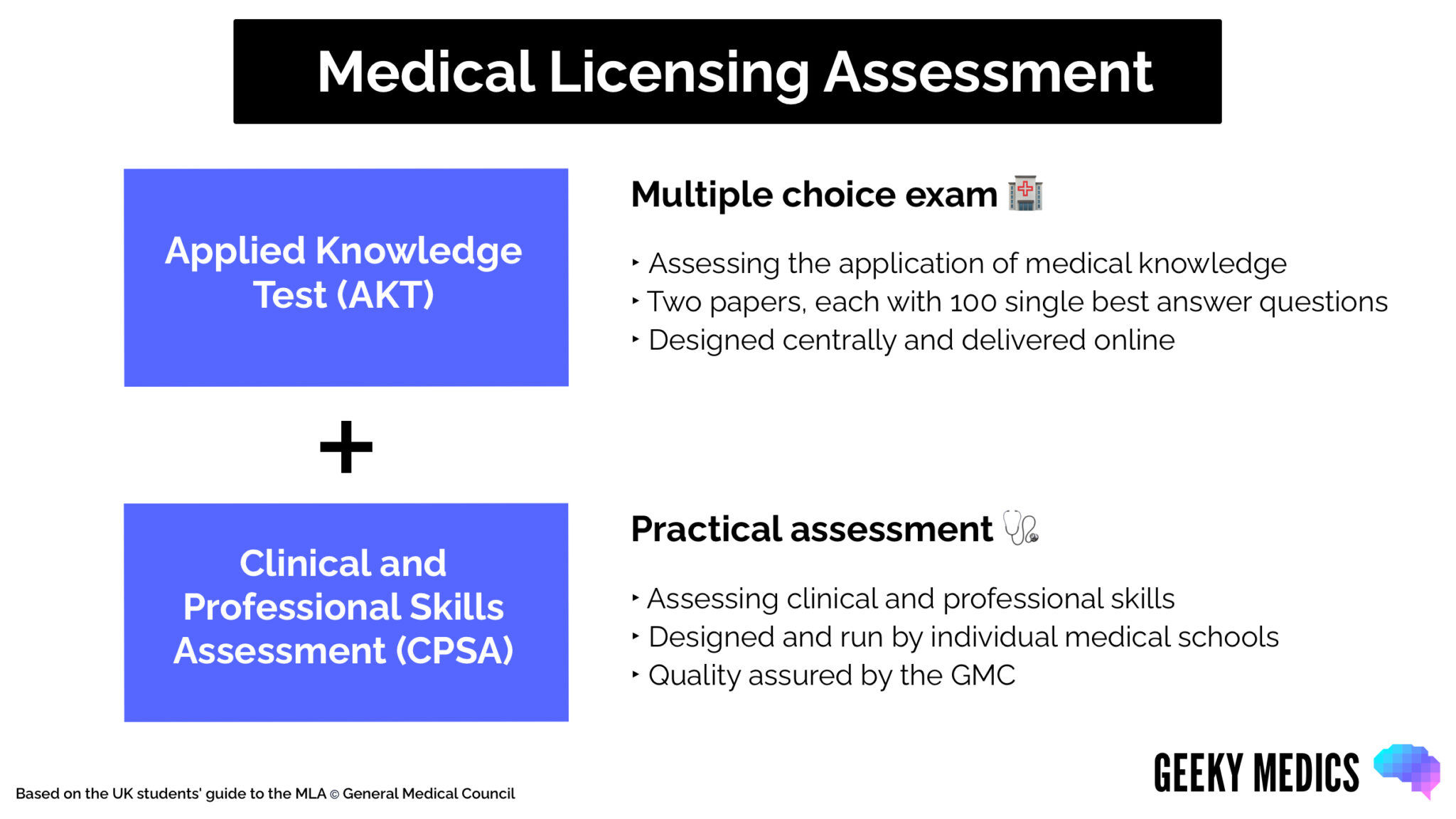- 📖 Geeky Medics OSCE Book
- ⚡ Geeky Medics Bundles
- ✨ 1300+ OSCE Stations
- ✅ OSCE Checklist PDF Booklet
- 🧠 UKMLA AKT Question Bank
- 💊 PSA Question Bank
- 💉 Clinical Skills App
- 🗂️ Flashcard Collections | OSCE, Medicine, Surgery, Anatomy
- 💬 SCA Cases for MRCGP
To be the first to know about our latest videos subscribe to our YouTube channel 🙌
The Applied Knowledge Test (AKT) is a multiple choice exam, taken as part of the UK Medical Licensing Assessment (MLA).
If you graduate from a UK medical school in the academic year 2024-25 or later, you must pass the Applied Knowledge Test before joining the medical register.
You will also need to pass the Clinical and Professional Skills Assessment (CPSA), the practical component of the MLA.
This article will discuss the Applied Knowledge Test (AKT), including how to prepare for the AKT and the format of the AKT.
Taking the AKT
The AKT will be a multiple-choice exam using single best answer (SBA) questions.
The AKT is being designed nationally, led by the Medical Schools Council. There will be a national bank of AKT papers, which will be allocated to individual medical schools. This is similar to the Prescribing Safety Assessment (PSA).
As part of the MLA, there will be two AKT papers, each with 100 SBA questions. Each paper will last two hours, although students with reasonable adjustments may be granted additional time.
The AKT will be delivered online under exam conditions at each medical school. There will be in-person invigilation, meaning you won’t be able to take the exam at home. Each medical school will be responsible for delivering the AKT exam locally.
Nationally designed, locally delivered
The AKT is being designed nationally, using representatives from UK medical schools. This means individual medical schools will not control the content of the AKT their students are taking. This is in contrast to other medical school exams, which are designed and delivered by the medical school.
However, the AKT is being delivered locally by individual medical schools. This means medical schools will be responsible for the practical arrangements, such as in-person invigilation and logistics on the day.
AKT questions
AKT questions will use a single best answer (SBA) format. Each question will follow the same structure:
- Stem
- Lead in question
- Five options (one correct answer, four incorrect answers)
It is essential to understand that, unlike traditional MCQs, the incorrect answers (distractors) may be plausible or partially correct. However, the correct answer is the ‘best’ answer to the scenario and lead in question.
You must use your higher-order thinking and clinical reasoning skills to identify the correct answer instead of relying on factual recall.
Remember, the exam is called the applied knowledge test and focuses on the application of medical knowledge (rather than just the ability to recall medical facts).
Stem
The stem will include a clinical scenario containing all the necessary information to answer the question.
Question stems in the AKT may include images, for example, clinical signs (e.g. a picture of a rash) or investigation findings (e.g. a 12-lead ECG recording).
AKT question stems are short and to the point. They will not contain excessive or irrelevant details (e.g. patient names). However, they should contain enough detail for you to answer the question.
Lead in question
The lead in question follows the stem and is the question you must answer.
Remember to read the question carefully, as often questions will be specific:
- “Which is the most appropriate initial investigation?” – this question asks you to identify the best first investigation to perform (e.g. a 12-lead ECG in a patient with chest pain)
- “Which is the most appropriate investigation to establish a diagnosis?” – this question asks you which investigation would be best placed to establish a diagnosis
Five options
Every AKT question will have five options. One will be the correct answer, and four will be incorrect distractors.
The options are usually arranged in alphabetical order.
Because this is a single best answer question, some of the incorrect distractors may be partially correct or plausible.
Example AKT style question
This SBA question is taken from the Geeky Medics UKMLA AKT question bank.
Stem
A 63 year old man has 2 hours of severe tearing chest pain that radiates through to his back. He has hypertension, type 2 diabetes mellitus and a 60 pack year smoking history.
His pulse rate is 97bpm, blood pressure is 194/92 mmHg in the right arm and 159/76 mmHg in the left.
Lead in question
Which is the most appropriate investigation to establish a diagnosis?
Answer options
- Abdominal aorta ultrasound
- CT angiography (correct answer)
- Chest X-ray
- ECG
- Invasive coronary angiography
Content of the AKT
The MLA content map sets out the content which could be tested as part of the MLA (both the AKT and the CPSA). The MLA content map contains a list of patient presentations and conditions which could appear in the AKT.
Each question in the AKT will be blueprinted to a patient presentation or condition listed in the MLA content map.
The conditions and presentations in the MLA content map are divided into 24 areas of clinical practice. Some presentations and conditions occur in multiple areas of clinical practice.
The AKT comprises two papers; the topics in each paper are split, as shown in Table 1.
Table 1. Breakdown of the applied knowledge test by area of clinical practice (adapted from Medical Schools Council FAQ document).
| Paper 1 (100 questions) | Paper 2 (100 questions) |
| Cardiovascular | Cancer |
| Respiratory | Breast |
| Gastrointestinal | Palliative & end of life care |
| Medicine of older adult | Peri-operative medicine & anaesthesia |
| Neurosciences | Musculoskeletal |
| Ophthalmology | Emergency medicine & intensive care |
| Endocrine & metabolic | Ear, nose & throat |
| Renal & urology | Child health |
| Infection | Mental health |
| Dermatology | Obstetrics & gynaecology |
| Sexual health | |
| Social/population health & research methods | |
| Medical ethics & law | |
| Both papers: acute medicine, primary care, surgery & clinical imaging | |
What is the AKT pass mark?
There are multiple AKT papers, so there is no set single passing mark for AKT papers.
Instead, each AKT paper will undergo standard setting. This determines the cut score for each paper (i.e. the score required to pass the paper).
The standard setting process takes into account variabilities in question difficulty between papers. For example, an AKT paper containing ‘harder’ questions will have a lower cut score than a paper with ‘easier’ questions.
Preparing for the AKT
Use the MLA content map
You must be familiar with the MLA content map to revise for the AKT. Medical schools should align their curriculums with the content map to ensure each condition and presentation is covered throughout the course.
Conditions
The MLA content map contains a list of 311 conditions (e.g. acute glaucoma, leukaemia), which could appear as a question in the AKT.
For more information, see our list of MLA conditions with links to relevant Geeky Medics articles.
Presentations
The MLA content map contains a list of 212 patient presentations (e.g. back pain, fatigue), which could appear as a question in the AKT.
For more information, see our list of MLA patient presentations with links to relevant Geeky Medics articles.
Areas of professional knowledge
The MLA content map also includes 12 areas of professional knowledge:
- Allergy and immunology
- Biomedical sciences
- Clinical biochemistry
- Clinical pharmacology and therapeutics
- Genetics and genomics
- Histopathology
- Human factors and quality improvement
- Laboratory haematology
- Medical ethics and law
- Microbiology
- Psychological principles
- Social and population health
Some questions in the AKT may align with these professional knowledge areas. For example, there could be SBA questions on medical ethics scenarios or interpretation of statistics.
Understand single best answer questions
As discussed above, single best answer questions are a specific type of multiple choice question.
You need to identify the ‘best’ answer to the question posed, and you may need to weigh up several options.
SBAs can be tricky because several of the options may be plausible. You need to be familiar with answering SBA questions before taking the AKT.
The Geeky Medics UKMLA AKT question bank contains over 2000 single-best-answer (SBA) questions, which you can use to help prepare for the UK Medical Licensing Assessment AKT.
Practice exam technique
Each AKT paper is two hours long and contains 100 questions. This means you have 72 seconds (1.2 minutes) to answer each question, which isn’t long.
You’ll need to manage your time effectively during the AKT to avoid running out of time. You should practice taking mock AKT exams under exam conditions when preparing for the AKT.
Improve your clinical reasoning
The AKT is an applied knowledge test and is testing your ability to apply medical knowledge. It is not a test of your ability to memorise and recall medical facts! Improving your clinical reasoning skills will help you answer AKT questions.
You can improve your clinical reasoning skills by seeing patients and discussing them with experienced clinicians. Assessing patients (taking histories, clerking patients, discussing investigations and management plans) will help you develop your clinical reasoning skills and your ability to apply medical knowledge.
Resources for the AKT
- Geeky Medics UKMLA AKT Question Bank (2000+ SBA Questions)
- List of MLA conditions mapped to Geeky Medics articles
- List of MLA presentations mapped to Geeky Medics articles
- GMC Medical Licensing Assessment content map
- Medical Schools Council MLA practice materials
References
- General Medical Council. Medical Licensing Assessment. Available from: [LINK]
- General Medical Council. MLA Content Map. Available from: [LINK]
- Medical Schools Council. The Applied Knowledge Test – FAQs for UK medical students. Published in January 2023. Available from: [LINK]





